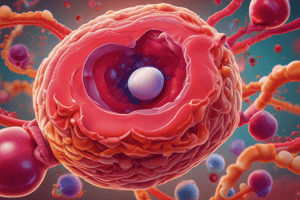Podcast
Questions and Answers
Explain the role of lipoproteins in transporting cholesterol in the blood.
Explain the role of lipoproteins in transporting cholesterol in the blood.
Lipoproteins serve as carriers for cholesterol in the blood. The three major types are LDL, HDL, and VLDL.
What is the difference between total cholesterol (TC) and non-HDL cholesterol?
What is the difference between total cholesterol (TC) and non-HDL cholesterol?
Non-HDL cholesterol is the difference between TC and HDL concentration, and it includes atherogenic cholesterol such as LDL, IDL, VLDL, chylomicron remnants, and lipoprotein(a).
Why is Apolipoprotein B (apoB) considered a high-risk marker in atherosclerosis?
Why is Apolipoprotein B (apoB) considered a high-risk marker in atherosclerosis?
Apolipoprotein B (apoB) is considered a high-risk marker in atherosclerosis because it is an indicator of the progression of atherosclerosis, and when an apoB particle becomes trapped within the vascular wall, it initiates the process.
What is the significance of elevated TG in relation to health risks?
What is the significance of elevated TG in relation to health risks?
What are the primary and secondary causes of dyslipidemias?
What are the primary and secondary causes of dyslipidemias?
What are the two types of familial hypercholesterolemia (FH)?
What are the two types of familial hypercholesterolemia (FH)?
What are some key drugs and conditions that can raise LDL and/or triglycerides?
What are some key drugs and conditions that can raise LDL and/or triglycerides?
What can result in an incorrect LDL calculation if the patient is not fasting?
What can result in an incorrect LDL calculation if the patient is not fasting?
What is the Friedewald equation used for?
What is the Friedewald equation used for?
What are the normal ranges for non-HDL levels?
What are the normal ranges for non-HDL levels?
What are the normal ranges for LDL levels?
What are the normal ranges for LDL levels?
What are the normal ranges for triglyceride levels?
What are the normal ranges for triglyceride levels?
What is the significance of non-HDL cholesterol in assessing cardiovascular disease risk?
What is the significance of non-HDL cholesterol in assessing cardiovascular disease risk?
Explain the role of apolipoprotein B (apoB) in atherosclerosis and its significance as a high-risk marker.
Explain the role of apolipoprotein B (apoB) in atherosclerosis and its significance as a high-risk marker.
What are the primary types of lipoproteins and their role in transporting cholesterol in the blood?
What are the primary types of lipoproteins and their role in transporting cholesterol in the blood?
How does elevated triglyceride (TG) levels relate to health risks, and what is a potential health complication associated with elevated TG?
How does elevated triglyceride (TG) levels relate to health risks, and what is a potential health complication associated with elevated TG?
Explain the Fredrickson classification and its significance in the classification of familial dyslipidemias.
Explain the Fredrickson classification and its significance in the classification of familial dyslipidemias.
What are the two types of familial hypercholesterolemia (FH) and how do they differ?
What are the two types of familial hypercholesterolemia (FH) and how do they differ?
What are the common causes of secondary dyslipidemia and why is it important to evaluate severe elevations in lipoprotein levels?
What are the common causes of secondary dyslipidemia and why is it important to evaluate severe elevations in lipoprotein levels?
Why is it important to ensure a patient's fasting status before interpreting lipoprotein levels, particularly triglycerides?
Why is it important to ensure a patient's fasting status before interpreting lipoprotein levels, particularly triglycerides?
Explain the significance of non-HDL cholesterol and apoB in assessing cardiovascular risk.
Explain the significance of non-HDL cholesterol and apoB in assessing cardiovascular risk.
What are the normal ranges for HDL levels in men and women, and why is HDL considered 'good' cholesterol?
What are the normal ranges for HDL levels in men and women, and why is HDL considered 'good' cholesterol?
Describe the key drugs and conditions that can raise LDL and/or triglycerides, and their implications for dyslipidemia management.
Describe the key drugs and conditions that can raise LDL and/or triglycerides, and their implications for dyslipidemia management.
Explain the impact of severe hypertriglyceridemia and its clinical significance in managing dyslipidemias.
Explain the impact of severe hypertriglyceridemia and its clinical significance in managing dyslipidemias.
Explain the significance of non-HDL cholesterol in assessing cardiovascular disease risk.
Explain the significance of non-HDL cholesterol in assessing cardiovascular disease risk.
What is the role of apolipoprotein B (apoB) in atherosclerosis and its significance as a high-risk marker?
What is the role of apolipoprotein B (apoB) in atherosclerosis and its significance as a high-risk marker?
What is the difference between total cholesterol (TC) and non-HDL cholesterol?
What is the difference between total cholesterol (TC) and non-HDL cholesterol?
Explain the impact of severe hypertriglyceridemia and its clinical significance in managing dyslipidemias.
Explain the impact of severe hypertriglyceridemia and its clinical significance in managing dyslipidemias.
Explain the Fredrickson classification and its significance in the classification of familial dyslipidemias.
Explain the Fredrickson classification and its significance in the classification of familial dyslipidemias.
What are the key drugs and conditions that can raise LDL and/or triglycerides?
What are the key drugs and conditions that can raise LDL and/or triglycerides?
What is the significance of non-HDL cholesterol in assessing cardiovascular risk?
What is the significance of non-HDL cholesterol in assessing cardiovascular risk?
Explain the role of apolipoprotein B (apoB) in atherosclerosis and its significance as a high-risk marker.
Explain the role of apolipoprotein B (apoB) in atherosclerosis and its significance as a high-risk marker.
What are the normal ranges for HDL levels in men and women, and why is HDL considered 'good' cholesterol?
What are the normal ranges for HDL levels in men and women, and why is HDL considered 'good' cholesterol?
What is the Friedewald equation used for?
What is the Friedewald equation used for?
What can result in an incorrect LDL calculation if the patient is not fasting?
What can result in an incorrect LDL calculation if the patient is not fasting?
Explain the impact of severe hypertriglyceridemia and its clinical significance in managing dyslipidemias.
Explain the impact of severe hypertriglyceridemia and its clinical significance in managing dyslipidemias.
Flashcards are hidden until you start studying




